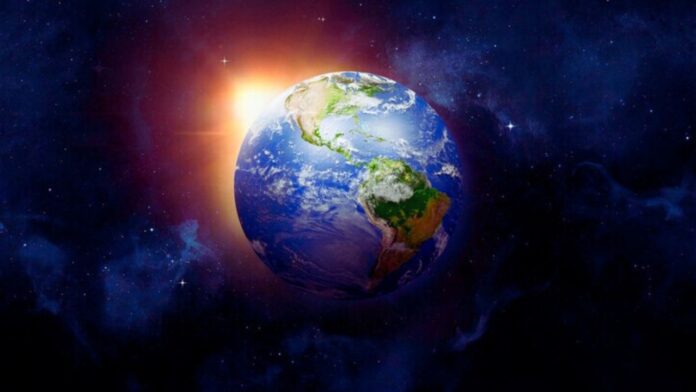Our planet Earth formed over 4.5 billion years ago and has a multilayered interior rather like an onion. At the very center lies a dense metallic core, composed of an outer molten layer and inner solid iron ball approximately 1500 miles wide. Surrounding this is the mantle, a thick layer of hot flowing rock that makes up the vast majority of Earth’s volume. And atop this sits the thin, rocky crust that we live on, floating on the mantle that churns below.
Within the mantle, scientists have long been puzzled by two continent-sized blobs of dense material sitting near the boundary with the core. Seismic waves passing through the mantle change speed and direction, allowing researchers to map out these mysterious regions. The blobs, dubbed “large low-shear velocity provinces” (LLSVPs), differ in density and composition from the rest of the surrounding mantle material. Seismic waves notably slow down when traversing them. One LLSVP sits beneath Africa, the other under the Pacific Ocean. But their origins have remained elusive. In addition, you can also read an article on- Webb Telescope Detects Stunning Quartz Clouds Around Unusual Exoplanet
The Moon’s Formation Through Cosmic Pinball
The leading explanation proposes that over 4 billion years ago, during Earth’s early formation, a dramatic cosmic collision occurred between our planet and Theia, a Mars-sized protoplanet. This monumental impact shattered Theia and sprayed debris into orbit around proto-Earth. Later, these fragments cooled and coalesced to form Earth’s nearest neighbor, the Moon.
New supercomputer simulations provide fresh insight into this cosmic pinball game. They reveal that molten material from shattered Theia remained at Earth’s surface following the collision, rather than fully mixing into the mantle. Being denser, this debris steadily sank through proto-Earth’s interior over millions of years, eventually coming to rest in the lower mantle where it created the two enduring LLSVP blobs that persist today. Additionally, you can also read about- Vast Reservoirs of Water Uncovered Deep in the Earth’s Mantle
Finding Definitive Proof of Theia Inside Earth
If the LLSVPs truly originated from Theia’s remains, they should have similar chemical signatures to lunar rocks gathered by the Apollo missions and meteorite samples. However, directly analyzing the mantle blobs is currently impossible, as no technology allows drilling thousands of miles down. But certain basalts emitted from deep mantle plumes may provide clues. Additionally, future lunar sample return missions could study the Moon’s interior for comparison.
Proving parts of Theia exist within Earth’s mantle could illuminate new details about the moon’s formation and evolution of the early solar system. For now, the ghost of the ancient impactor may continue lurking silently in the depths of our planet’s belly. But unlocking its secrets could reveal our cosmic history and origins.
The Hunt for Theia Fragments
Since the giant impact theory emerged five decades ago, scientists have pondered a nagging question – where are remnants of Theia today? This new research proposes a bold answer, with chunks of the destroyed protoplanet hiding in plain sight within Earth’s mantle. However, many details remain debated.
Some experts argue Theia’s material would have thoroughly mixed into Earth’s mantle over billions of years. The study team counters their advanced simulations show the debris stayed distinct and sank to the bottom. Resolution may come from chemical analysis showing identical signatures between the LLSVPs and lunar samples.
Accessing Earth’s deepest interior presents formidable challenges. But as technology progresses, humanity inches closer to unveiling our planet’s long-hidden secrets. Proving parts of Earth originated from Theia would illuminate a formative cosmic collision that created the Moon and set the stage for life itself. Our quest to unravel Earth’s past persists, revealing origins and mysteries one step at a time. If you want you can also read- SpaceX Rocket to Uncover Origins of Earth’s Core in Asteroid Psyche Mission
The Moon and Earth, Formed Through Violence
Earth’s large orbiting Moon companion is uniquely large relative to its planet. Leading theories posit a collision between proto-Earth and a Mars-sized celestial body, named Theia. This catastrophic cosmic event melted and sprayed debris into space that cooled into the Moon 4.5 billion years ago.
Far from a placid process, our neighborhood’s history is marked by violence. Worlds collided at high speed, melting and reforming. Rock and dust circled Earth before becoming our airless satellite. Creation tales often highlight chaos before order.
This new evidence implies Theia’s remains settled into Earth’s mantle, avoiding complete mixing. Strange to envision parts of a destroyed alien world residing in our planet’s depths. Earth and Moon both hold scars from the collision that birthed one and altered the other forever.
You May Find Interest: NASA’s Revolutionary Asteroid Sample Offers Clues to Life’s Origins on Earth


















![10 Countries With the Best Healthcare in the World [Statistical Analysis] Countries With the Best Healthcare in the World](https://articleify.com/wp-content/uploads/2025/07/Countries-With-the-Best-Healthcare-in-the-World-1-150x150.jpg)










